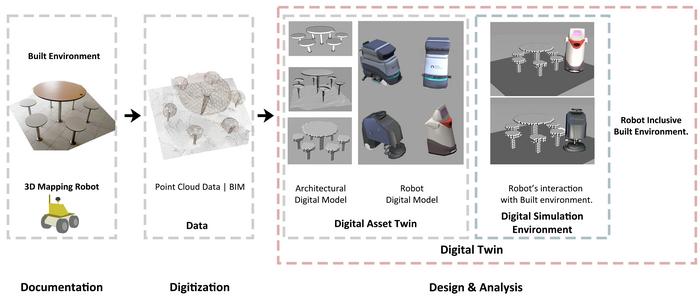Humans and robots are increasingly interacting within built environments such as cities, buildings, walkways, and parks. Offering adaptability, cost-effectiveness, and scalability, robots are gradually being integrated into various aspects of everyday life, from manufacturing to healthcare to hospitality.

Credit: SUTD
Humans and robots are increasingly interacting within built environments such as cities, buildings, walkways, and parks. Offering adaptability, cost-effectiveness, and scalability, robots are gradually being integrated into various aspects of everyday life, from manufacturing to healthcare to hospitality.
“Ensuring that robots can navigate and operate effectively within built environments is crucial for their widespread adoption and acceptance,” said Associate Professor Mohan Rajesh Elara from the Singapore University of Technology and Design (SUTD).
To have fully autonomous service robots operate in human environments, however, is still a distant goal. Spatial limitations in the built environment restrict a robot’s performance capability. In designing robot-inclusive environments, robot interaction within a built environment must be examined. The current methods used for this involve real-life testing and physical experiments that are costly, time-consuming, and labour-intensive.
To address these limitations, Assoc Prof Mohan and his SUTD team explored an innovative approach in their paper ‘Enhancing robot inclusivity in the built environment: A digital twin-assisted assessment of design guideline compliance’. Here, they demonstrate a novel methodology utilising digital twins to establish the usefulness of built environment design guidelines for robots. They also model some robot archetypes and environments as digital twins to examine robot behaviour within the environments.
A digital twin is a virtual replica of a physical object in a virtual version of its environment. “The digital twin approach offers several key advantages, including the ability to simulate real-world scenarios, enable virtual testing of robot interactions, and provide insights into compliance with design guidelines before physical implementation,” said Assoc Prof Mohan. Moreover, using digital twins allows real-time monitoring, hazard identification, and training a robot’s algorithm before deployment.
In the study, Assoc Prof Mohan uses digital twins to analyse the robot-friendliness of the built environment and prepare for robot deployment. The methodology used is divided into three phases: documentation, digitisation, and design analysis.
First, on-site documentation of the environment is necessary for the simulation. It can be done via direct data collection, laser scanning, or photogrammetry techniques. Ideally performed during the building’s design process, direct data collection uses Building Information Modelling (BIM)—a process of generating and managing digital representations of the building. When a building has already been constructed, laser scanning or photogrammetry techniques can be used to generate point cloud data for processing.
Second, digitisation focuses on making the built environment’s digital model suitable for the robot simulation software. In this step, point cloud data will be reconstructed into a digital space and used to generate three-dimensional (3D) models of the built environment.
Finally, the digital model is designed and analysed. Using the digitised model of the environment in the robot simulation software, the behaviours and interactions of various robots are tested within the environment. Virtual scenarios are made based on existing design guidelines of built environments, and the robots are assessed on their navigation, path planning, and interaction with the surrounding.
In one case study, Assoc Prof Mohan used digital twins to test four different cleaning robots in six different environments that adhered to Accessibility Design Guidelines. Of the four robots, one completed the most goals and performed the best in the simulated environments. It is important to note that robot inclusiveness does not always translate to robot performance efficiency. However, an inclusive environment does promote better accessibility for robots, allowing them to complete their tasks properly.
With robots increasingly being used in urban applications such as cleaning, logistics, and building maintenance, this study’s findings will help improve design guidelines for built environments to accommodate robots. Better design guidelines will allow the seamless integration of robots into human-centric spaces and their enhanced efficiency in various applications.
“The findings could shape future space design by emphasising flexibility, adaptability, and accessibility to accommodate robot interactions,” Assoc Prof Mohan adds.
In the future, the research team aims to extend the current methods and autonomously generate the infrastructure modifications required to improve the accessibility of mobile robots through the use of design, AI and technology. Assoc Prof Mohan also hopes to develop a set of design guidelines and recommendations for building robot-friendly infrastructure.
Journal
Buildings
Article Title
Enhancing robot inclusivity in the built environment: A digital twin-assisted assessment of design guideline compliance
Article Publication Date
23-Apr-2024



